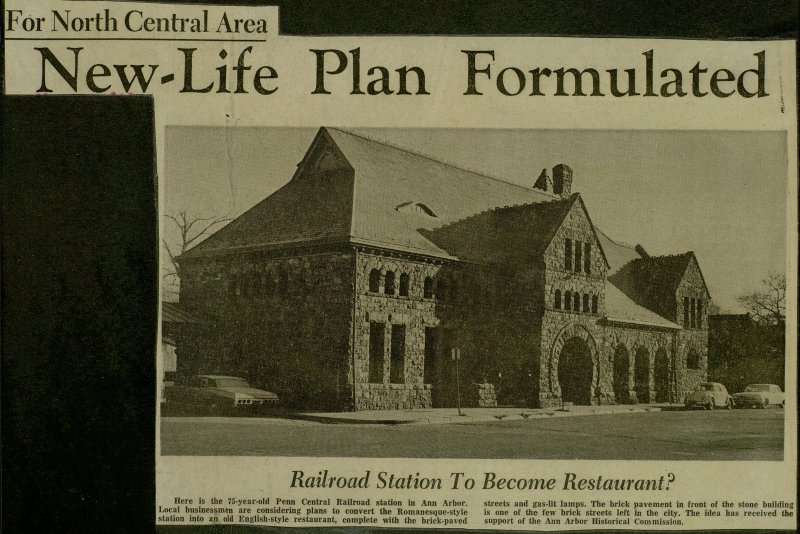New-Life Plan Formulated


A multimillion-dollar real estáte development project is being planned for the north central área of Ann Arbor by two young businessmen and a group of architectural advisers, designers and restaurant experts. The project, designed to breathe life into a decaying section of town, would renovate the 75-year-old Penn Central Railroad station into an oldEnglish style resturant and provide new construction on top of the hill overlooking Carey Street (the section of Depot St. in front of the railroad station). The intersection of Detroit and Depot Streets would be more accurately defined with landscaping and parking lots, the developers say. The project planners, George F. Field Jr. and Samuel D. Swisher, son of local realtor John D. Swisher Jr., have not finalized plans because of the changing nature of such a job. The hilltop construction site complete with landscaped terraces down to the street would be used for a motel, a medical office building or an office building for a local company, the developers report. Although the construction stage of the development is still tentative, it is the key to whether the restaurant becomes a reality. Their idea of restoring the Penn Central Railroad depot has won the support of the Ann Arbor Historical Commission. In a letter, Herbert H. Bartlett, chairman of the Commission, said: "It has a special apipeal to us as a very acceptable means of preserving this interesting landmark." "Architecturally, this building 'is a widely acclaimed example Lof the Romanesque style. Struc[turally, it is an interesting example of the skill and artistry of Ann Arbor's oíd Germán stonemasons, regretably now largely supplanted by modern materials and methods. The restaurant, as envisioned [by the young developers would ' incorpórate and dramatize the architectural features of the railroad depot. "We have researched this to the finest detail. . . if any restaurant can succeed in Ann Arbor, this one can," Field said. A key consultant in the restaurant venture is William T. Carter, professor of art at the U-M, who has worked in architecture interior design and space planning with such firms as Ford and Earl Design Associates, Suren Pilafian, Victor Gruen Associates, Stran-Steel Corp. product design división and Joseph St. Cyr and Associates. Carter will be responsible for both ,the architecture and interior design. Another important ally in the restaurant venture is Christian E. Pohl, president of C. E. Pohl Associates of Detroit, who has worked with Prof. Carter on previous assignments. He is working on an "identity" for the operation which would be carried through on menu design and advertising. The consultant and manager of the restaurant is Henry J. Helle of 2887 Maple Blvd., who has held managerial positions in nearly every aspect of the food industry. One of the special aspects of the project is the commissioning of artist Milton Kemnitz to produce special paintings and drawings for the railroad restaurant. But the developers who have spotted the potential for doing more in "old town" than merely refurbishing the railroad station into a $500,000 resturant, are going for a "touchdown pass" with an entire commercial development. The way the four areas of the depot would be renovated are as folows: the main depot building and baggage building on the east end of the depot would be used for a restaurant; the Penn Central Company would use the west express building for passenger facilities; the Garden Court would feature a vaulted, skylighted enclosed area with trees and a fountain; the main restaurant would be divided into the main dining room and a clubroom - or a club car-type cocktail and intímate dining area, The entire project would be designed to capture the atmosphere of "old town" complete with the brick-paved streets and gas lit lamps from the terraced hill to the Depot. The promotional program for the restaurant area would include the use of a double-decked English bus to assist in alleviating parking and traffic problems. This would also serve as a community landmark and add color to the city. They plan to use a three-door London taxi cab to shuttle patrons to the Depot.
Article
Subjects
Liz Elling
Real Estate Development - Ann Arbor
Real Estate - Developers & Managers
Commercial Real Estate
Ann Arbor Historic District Commission
Has Photo
Ann Arbor News
Old News
William T. Carter
Samuel D. Swisher
Milton Kemnitz
John D. Swisher Jr.
Herbert H. Bartlett
Henry J. Helle
George F. Field Jr.
Christian E. Pohl
Penn Central Station
Detroit St.
Depot St.
Carey St